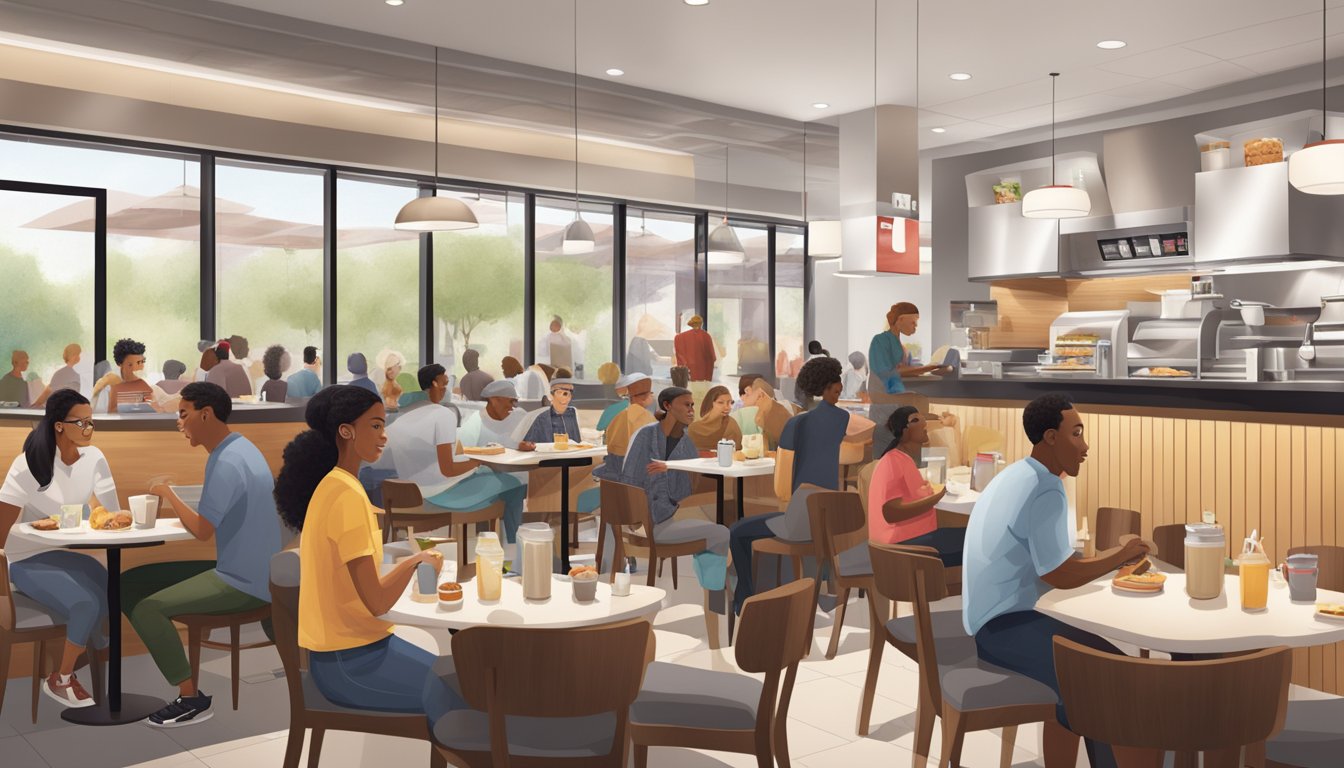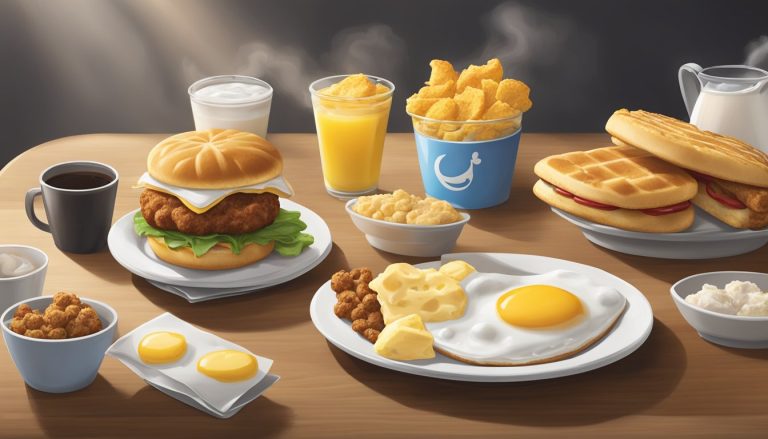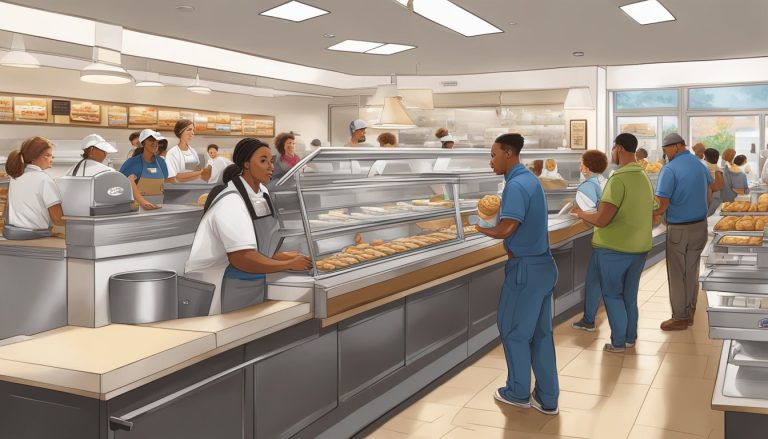Chick-fil-A has become a powerhouse in the fast-food industry, known for its chicken sandwiches and exceptional customer service. The company’s breakfast offerings have played a significant role in its success, with hand-rolled biscuits and chicken minis becoming fan favorites. Chick-fil-A’s breakfast menu exemplifies the shift towards higher-quality, made-to-order options that have come to define the fast-casual dining segment.
The rise of fast-casual dining has transformed the restaurant industry, blending the convenience of fast food with the quality and atmosphere of casual sit-down establishments. This trend aligns perfectly with changing consumer preferences for fresher ingredients, customizable options, and enhanced dining experiences. Chick-fil-A has capitalized on these shifts by maintaining its commitment to quality while expanding its menu and improving its restaurant designs.
As the fast-casual sector continues to grow, Chick-fil-A’s breakfast offerings serve as a prime example of how traditional fast-food chains can adapt and thrive in this new landscape. The company’s focus on freshly prepared items and efficient service has resonated with customers across various income levels, solidifying its position as a leader in the evolving restaurant industry.
The Evolution of Fast Casual Dining
Fast casual dining transformed the restaurant industry by combining quick service with higher quality food and ambiance. This segment emerged as a response to changing consumer preferences and economic factors.
Defining Fast Casual
Fast casual restaurants bridge the gap between quick-service and casual dining establishments. They offer made-to-order food with fresh ingredients, customizable options, and a more upscale atmosphere than traditional fast food.
Prices at fast casual eateries typically range from $8 to $15 per meal. Service is usually counter-style, with food brought to the table. Popular fast casual chains include Chipotle, Panera Bread, and Shake Shack.
These restaurants emphasize quality ingredients, health-conscious options, and a more inviting dining environment. Many feature open kitchens and modern decor to create a premium fast food experience.
History and Market Growth
The fast casual concept emerged in the 1990s but gained significant traction in the early 2000s. Chains like Chipotle and Panera Bread pioneered the format, attracting consumers seeking healthier, fresher alternatives to traditional fast food.
Fast casual saw rapid expansion in the 2000s and 2010s:
- 2002: 9,000 fast casual restaurants in the U.S.
- 2015: Over 25,000 locations
The segment’s market share grew from 5% of the restaurant industry in 2007 to 11% by 2015. This growth outpaced both quick-service and full-service restaurant segments.
Factors driving fast casual’s rise included:
- Increased focus on food quality and transparency
- Demand for customizable menu options
- Appeal to health-conscious millennials
Impact of the Great Recession
The 2008-2009 Great Recession significantly influenced fast casual dining’s growth. As consumer spending tightened, many diners traded down from casual sit-down restaurants to more affordable fast casual options.
Fast casual chains offered a perceived value proposition:
- Higher quality food than quick-service restaurants
- Lower prices than full-service casual dining
- Convenient, quick meal options for time-pressed consumers
During this period, fast casual was one of the few restaurant segments to see sales growth. From 2007 to 2012, fast casual sales increased by 13% annually, while full-service restaurant sales declined.
The recession accelerated existing trends toward convenience and value, cementing fast casual’s place in the dining landscape. This shift in consumer behavior continued even as the economy recovered, fueling further expansion of the fast casual segment.
Chick-fil-A’s Market Position

Chick-fil-A has solidified its standing as a major player in the fast-food industry through consistent growth and strategic expansion. The company’s unique approach to customer service and menu offerings has propelled it to the forefront of the market.
Brand History and Values
Founded in 1946 by S. Truett Cathy, Chick-fil-A started as a small diner called the Dwarf Grill in Hapeville, Georgia. The company’s signature chicken sandwich was introduced in 1964, marking the beginning of its focused menu strategy.
Chick-fil-A’s core values, including customer service excellence and quality ingredients, have remained central to its brand identity. The company’s closed-on-Sunday policy reflects its commitment to Christian principles and employee well-being.
These values have fostered strong brand loyalty among customers. Chick-fil-A’s dedication to hospitality and food quality has set it apart from competitors in the fast-food sector.
Same-Store Sales and Revenue
Chick-fil-A’s financial performance has been impressive, with consistent growth in same-store sales and revenue. In 2022, the chain served 527 million chicken sandwiches, highlighting its popularity and market demand.
The company’s average unit volumes are among the highest in the fast-food industry. This strong performance is attributed to:
- Efficient operations
- High customer satisfaction
- Limited menu focused on chicken products
- Strategic location selection
Chick-fil-A’s pricing strategy targets middle-income families and individuals, balancing affordability with quality. This approach has contributed to steady revenue growth and market share expansion.
International Expansion
While Chick-fil-A has established a dominant presence in the United States, its international footprint remains limited. The company has taken cautious steps towards global expansion, focusing on:
- Canada: Opened its first international location in Toronto in 2019
- United Kingdom: Launched a pilot location in Reading, England
Chick-fil-A’s international expansion strategy emphasizes maintaining brand consistency and quality standards across new markets. The company faces challenges in adapting its menu and operations to diverse cultural preferences and regulations.
Despite its conservative approach to global growth, Chick-fil-A continues to explore opportunities for international expansion. The company aims to replicate its domestic success while navigating the complexities of foreign markets.
Consumer Experience in Chick-fil-A

Chick-fil-A has built a reputation for exceptional customer experiences through attentive service, quality food, and innovative digital offerings. The company consistently ranks at the top of customer satisfaction surveys in the fast food industry.
Customer Service and Satisfaction
Chick-fil-A’s commitment to hospitality sets it apart from competitors. The chain has ranked No. 1 in customer satisfaction for nine consecutive years according to the American Customer Satisfaction Index. In 2023, Chick-fil-A scored 85 out of 100, a 2% increase from the previous year.
Employees are trained to provide polite, attentive service. The signature phrase “my pleasure” embodies their approach to hospitality. Staff members often go above and beyond, assisting customers to their tables or refilling drinks.
This focus on service quality has fostered strong customer loyalty. Many patrons cite the friendly staff as a key reason for returning to Chick-fil-A locations.
Quality of Ingredients and Menu
Chick-fil-A emphasizes high-quality ingredients in its menu offerings. The chain uses chicken raised without antibiotics and prepares food fresh daily in each restaurant.
Popular items include:
- Original Chicken Sandwich
- Waffle Fries
- Grilled Chicken Nuggets
The company has expanded its menu to include healthier options like salads and grilled items. Nutritional information is readily available, allowing customers to make informed choices.
Chick-fil-A’s commitment to food quality extends to taste and consistency. Many customers praise the reliable flavor and freshness of menu items across different locations.
Digital Engagement and Accessibility
Chick-fil-A has embraced digital technology to enhance customer convenience. The Chick-fil-A mobile app allows for easy ordering and payment, reducing wait times and streamlining the dining experience.
Features of the app include:
- Mobile ordering for pickup or delivery
- Customizable menu items
- Rewards program for frequent customers
The chain has also implemented drive-thru innovations, such as outdoor meal delivery and multi-lane ordering systems. These improvements have increased efficiency, especially during peak hours.
Chick-fil-A’s digital initiatives have improved accessibility for customers with diverse needs and preferences. The combination of user-friendly technology and attentive in-person service contributes to the brand’s strong customer satisfaction ratings.
Innovations in Service and Delivery

Chick-fil-A has embraced technological advancements to enhance customer experience and streamline operations. The company has implemented several key innovations across its digital platforms, delivery services, and restaurant layouts.
Adoption of Digital and Mobile Platforms
Chick-fil-A’s mobile app has revolutionized the ordering process. Customers can now place orders, customize meals, and pay directly through their smartphones. The app also features a rewards program, encouraging repeat visits.
Digital menu boards in restaurants provide real-time updates on menu items and pricing. These boards allow for easy changes and promotional displays.
Self-service kiosks have been introduced in many locations. These kiosks reduce wait times and allow customers to browse the menu at their own pace.
Mobile payment options like Apple Pay and Google Wallet are now accepted. This integration speeds up transactions and improves convenience for tech-savvy customers.
Catering and Third-Party Delivery Services
Chick-fil-A has expanded its catering services to meet growing demand. The company offers customizable catering packages for various event sizes and types.
Online catering ordering systems simplify the process for customers. These systems provide detailed menu options, pricing, and scheduling features.
Partnerships with third-party delivery services like DoorDash have broadened Chick-fil-A’s reach. Customers can now enjoy their favorite meals without leaving home or office.
Chick-fil-A has implemented quality control measures for delivered orders. Special packaging ensures food remains fresh and presentable during transit.
Drive-Thru and Dine-In Innovations
Chick-fil-A has redesigned its drive-thru system to improve efficiency. Multiple lanes and outdoor ordering tablets help reduce wait times during peak hours.
Face-to-face ordering with tablet-equipped staff members personalizes the experience. This approach allows for better communication and order accuracy.
The company has tested autonomous delivery vehicles in select locations. These robots can deliver orders within a one-mile radius of participating restaurants.
Indoor renovations focus on creating a more comfortable dining atmosphere. Updated seating arrangements and decor aim to enhance the in-restaurant experience.
Digital order status boards keep customers informed about their order progress. These boards reduce confusion and improve overall customer satisfaction.
Competitive Landscape
Chick-fil-A operates in a dynamic and crowded fast-food market, facing competition from established giants and emerging fast-casual brands. The company’s unique positioning and strong brand loyalty have helped it carve out a significant market share, but challenges remain.
Comparison with QSR and Fast Food Chains
Chick-fil-A competes directly with major quick-service restaurant (QSR) chains like McDonald’s, KFC, and Taco Bell. Despite being closed on Sundays, Chick-fil-A’s average unit volume of $4.4 million surpasses many competitors. McDonald’s, with its extensive breakfast menu, remains a formidable rival in the morning daypart.
KFC, another chicken-focused chain, lags behind Chick-fil-A in terms of per-store sales. Taco Bell has made inroads into the breakfast market, but its offerings differ significantly from Chick-fil-A’s menu.
Yum! Brands, which owns KFC and Taco Bell, leverages its multi-brand portfolio to compete across various segments of the fast-food industry.
Emerging Fast Casual Competitors
The fast-casual sector presents new challenges for Chick-fil-A. Chipotle, known for its customizable options and focus on fresh ingredients, appeals to health-conscious consumers. While not a direct competitor in the breakfast space, Chipotle’s success highlights changing consumer preferences.
Newer entrants like Raising Cane’s and Zaxby’s focus on chicken offerings, potentially eroding Chick-fil-A’s market share. These chains often emphasize quality and simplicity in their menus.
Jersey Mike’s and Firehouse Subs compete in the sandwich category, offering alternatives to Chick-fil-A’s chicken sandwiches. Their rapid expansion indicates growing consumer interest in diverse quick-service options.
Market Share and Brand Differentiation
Chick-fil-A has established a strong competitive position through its unique business model and exceptional customer service. The company’s annual revenue exceeds $11 billion, demonstrating its significant market presence.
Brand loyalty remains a key differentiator for Chick-fil-A. Its commitment to quality and customer experience has created a devoted following. This loyalty helps insulate the brand from some competitive pressures.
Product innovation plays a crucial role in maintaining market share. Chick-fil-A regularly introduces new menu items to keep pace with changing consumer tastes. The company’s breakfast offerings, including its chicken biscuits, set it apart from many competitors.
Chick-fil-A’s expansion into new markets continues to drive growth, with over 2,600 locations across 47 states. This broad geographic presence allows it to compete effectively against both national chains and regional favorites like Whataburger.
Economic and Industry Challenges
Fast-casual dining faces significant economic pressures and industry shifts. Rising costs, labor issues, and efficiency demands shape the landscape for chains like Chick-fil-A.
Effects of Inflation on Food Prices
Inflation has driven up food costs, impacting restaurant profit margins. In 2024, ingredient prices rose 6% year-over-year, squeezing profitability. Chains like Chick-fil-A face tough choices:
• Absorb costs and reduce profits
• Raise menu prices and risk losing customers
• Find cheaper ingredients and potentially lower quality
Many opt for modest price increases. Chick-fil-A raised prices 3% in late 2024, aiming to balance affordability and profitability.
Supply chain disruptions further compound the issue. Shortages of key ingredients like chicken lead to temporary menu changes or limited availability.
Minimum Wage and Labor Costs
Rising minimum wages affect fast-casual restaurants’ bottom lines. As of 2025, 22 states have minimum wages above $15/hour. This impacts labor costs significantly.
Chick-fil-A’s average hourly wage is $13.50, below some competitors. The company faces pressure to increase pay to attract and retain workers.
Higher labor costs lead to:
• Reduced staff hours
• Increased automation
• Higher menu prices
Some chains explore technology like self-order kiosks to offset labor costs. Chick-fil-A has been slower to adopt such measures, focusing on personal service.
Importance of Speed and Efficiency
In fast-casual dining, speed and efficiency are crucial. Customers expect quick service without sacrificing quality. Average wait times industry-wide:
| Service Type | Average Wait Time |
|---|---|
| Drive-thru | 4 minutes 15 seconds |
| Counter | 3 minutes 30 seconds |
| Mobile order | 2 minutes 45 seconds |
Chick-fil-A’s innovative dual drive-thru lanes reduce wait times by 30 seconds on average. Mobile ordering, now accounting for 20% of sales, further improves efficiency.
Order accuracy remains a challenge. Industry average: 87% accuracy. Chick-fil-A leads with 95% accuracy, attributed to thorough staff training.
Balancing speed with quality is an ongoing challenge. Rushed service can lead to mistakes, while slow service frustrates customers. Successful chains find the sweet spot between efficiency and customer satisfaction.
Strategic Moves and Future Outlook
Chick-fil-A continues to innovate and adapt to the evolving fast-casual dining landscape. The company’s focus on consumer preferences, sustainability, and market expansion positions it for continued growth.
Adapting to Changing Consumer Trends
Chick-fil-A recognizes the importance of staying ahead of consumer preferences. The chain has expanded its breakfast menu to cater to the growing demand for morning dining options.
In response to health-conscious customers, Chick-fil-A has introduced lighter fare such as grilled chicken options and salads. The company also embraces digital ordering and mobile apps to enhance convenience.
Chick-fil-A’s commitment to food quality remains a key differentiator in the fast-casual segment. The chain sources premium ingredients and prepares meals fresh on-site, appealing to customers seeking a superior dining experience.
Potential for New Market Segments
Chick-fil-A’s growth strategy includes targeting new demographics and geographic areas. The company is expanding its presence in urban centers and exploring international markets.
To attract younger consumers, Chick-fil-A is enhancing its social media presence and engaging in targeted marketing campaigns. The chain also experiments with menu innovations to appeal to diverse taste preferences.
Chick-fil-A’s franchise model allows for controlled expansion while maintaining consistency across locations. This approach enables the company to enter new markets strategically and maintain its high standards of service.
Sustainability and Corporate Social Responsibility
Chick-fil-A is increasing its focus on sustainability initiatives. The company aims to reduce its environmental impact through energy-efficient restaurant designs and sustainable packaging.
Community involvement remains a core value for Chick-fil-A. The chain supports local organizations and offers scholarship programs for employees, enhancing its reputation as a socially responsible brand.
Chick-fil-A’s commitment to ethical sourcing practices aligns with growing consumer demand for transparency in the food industry. The company continues to improve its supply chain to meet these expectations.




